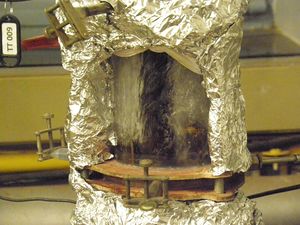Small distillation column
The small distillation column in the PMC labs is a pilot scale separations unit. This unit has 10 bubble-cap trays.The column is highly nonlinear and presents a formidable challenge to linear control systems.
Contents
Operating Region
The small distillation column has a very narrow operating region. The exact constraints will depend on the specific base-layer setup. During the 2010 CML732 project the maximum plate 10 temperature that could be maintained while keeping column stable, was 81 °C. The maximum reflux IP transducer signal that could be implemented while still maintaining column stability was 14 mA. The exact IP signal will however depend strongly on the calibration of the IP transducer. A feed mixture of 30% ethanol provided the most operational flexibility.
This operating region is still applicable after the 2013 rebuild.
Available Instrumentation and Final Control Elements
Several measurements are available on the column. Temperature measurements are available on all the trays. A differential pressure cell on the reboiler can be used for level calculations. The level in the distillate drum is inferred via image processing on teh floating yellow ball. There are three control valves. The control valves are situated on the reflux, bottoms and top product lines. The reboiler is equipped with an electrical heating element whose duty is controlled via a thyristor.
Recent Improvements
2010 modifications:
A pump has been installed in the bottoms product line. The increase in head has dramatically improved the dynamic performance of the bottoms product control valve. Temporary insulation of the column with paper towels and aluminium foil has increased the temperature obtained throughout the column with 12 °C. It also offers the advantage of being hazard free and easily removable.
2013 modifications:
The intermediate feed drum has been removed and the column is now directly fed from the combined products receiving drum. This eliminates the feed drum level control problem which could not be automated in the past due to lack of a feed valve.
The insulation applied in 2010 has been removed. The resulting high internal reflux results in the azeotropic composition of the ethanol/water mixture being easily achieved in the distillate.
Operating Problems
Flooding is the biggest problem encountered during the column operation. Flooding usually start on the bottom tray and then propagates up to stage 10. Downcomers that are too close to the next tray may be a primary factor responsible for this tendency. At high vapour flow rates, reversal of flow in the feed section is sometimes encountered.
Advanced Process Control
Several advanced process control software packages have been implemented on the column: Fuzzy Logic control (2013), Honeywell RMPCT (2010), Generic Simulink Based MPC (2010), Aspentech DMC Plus (2008) and Aspentech SmartStep (2008).The associated software can be found in the following directories (newest last): [1][2]

